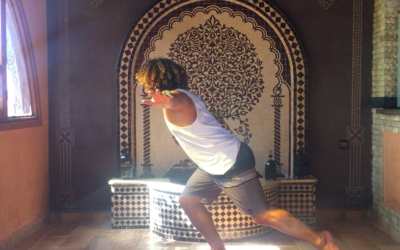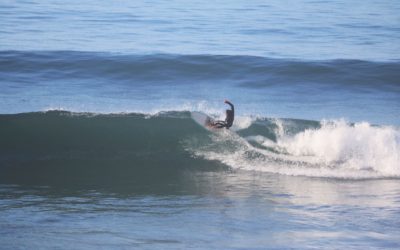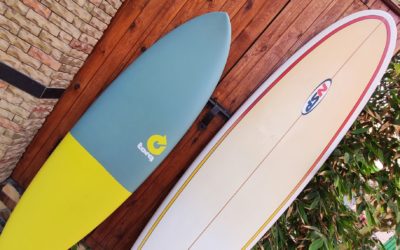Table of contents
Fins on a surfboard are far more useful than one might think. Why are these “pieces of plastic” under our board so expensive? What are the characteristics of a fin? Read on to discover more about the surf fin, and its role in the waves;
The basic parameters of a fin, and how it works:
The surface
More surface will bring more hold and control. Less surface will leave more freedom under the feet.
The rake
(backwards curvature): More curvature will lead to longer curves. Less rake means more radical manoeuvres.
Base length
A long base will have great propulsion. A short base will be useful for short turns and more slack.
Depth
(height of the fins): Depth brings more grip in the glide. Less depth will help for more release and speed.
Foil
(aerodynamic shape of the fins edge):
50/50 = two symmetrical convex sides (central or rear fin of a quad)
Flat = outside convex, inside flat on the sides, more control
Concave = outside convex and inside concave, more lift, more speed
Flex
(resistance to deformation): very flexible fins are often found on foam boards or beginner’s boards. This allows (in addition to avoiding accidents) soft support and high tolerance. High-performance fins often have little flex, allowing more control and responsiveness.
Cant
(inclination of the lateral fins towards the rails): more cant allows good control of the turns on the rail but slows down the glide. And the opposite is true with little cant.
How to Choose Your Fins?
Based on these parameters, you can get very different riding sensations with the same board just by changing the fins. Each characteristic will be explained in more detail on the website or on the fin packaging, but it’s important to ask yourself the right questions to find the model that suits you best.
Your weight?
Fins come in different sizes, often indicated relative to body weight. You just need to know where you stand to choose the right size.
Which fin system?
There are several main fin attachment systems, but you need to be sure which one your board has so the fins can be properly installed.
For what kind of waves?
Big, hollow waves require more control, whereas small summer waves are better suited to fins that allow more freedom in maneuvers.
What’s your surf style?
Do you prefer a relaxed cruising style on the wave, or are you more into performance and radical maneuvers?
You can fine-tune all the characteristics of your fins to find the model that fits you. Don’t forget your local surf shop — they’ll likely be able to give you great advice on the subject.
Today, there is a wide variety of innovative fins on the market. One standout is S-Wings, a French company that has developed fins with an extended trailing edge that twists during maneuvers, creating powerful propulsion on the release.
Fins can therefore fulfill very different ride demands. To go even further, you can also change the setup and number of fins on your board. We’ll cover those options in another article.
FAQ – Frequently Asked Questions About Surfboard Fins
Fins help control direction, stabilize the board, and optimize glide. Without fins, the board would slide out and lose maneuverability.
The price depends on the materials used, the technology (like S-Wings fins), and their performance level. The more technical and lightweight they are, the more expensive they tend to be.
Absolutely! Fins have a big impact on how your board behaves. Changing fins can transform your ride — making it smoother, more radical, faster, or more controlled.
Size generally depends on your body weight. Most brands classify fins by weight range (S, M, L…). Choosing the right size is essential for maintaining both control and maneuverability.
No. There are different fin systems (FCS1, FCS2, Futures…). You need to make sure your fins are compatible with your board’s fin box system.
It depends on your board’s setup and the type of ride you’re aiming for (single, twin, thruster, quad, etc.). Each configuration offers a different feel on the wave.
It can seem complicated, but each factor plays a role in how your board performs. The key is to experiment, ask for advice at your local surf shop, and find what suits your style, skill level, and wave conditions.







